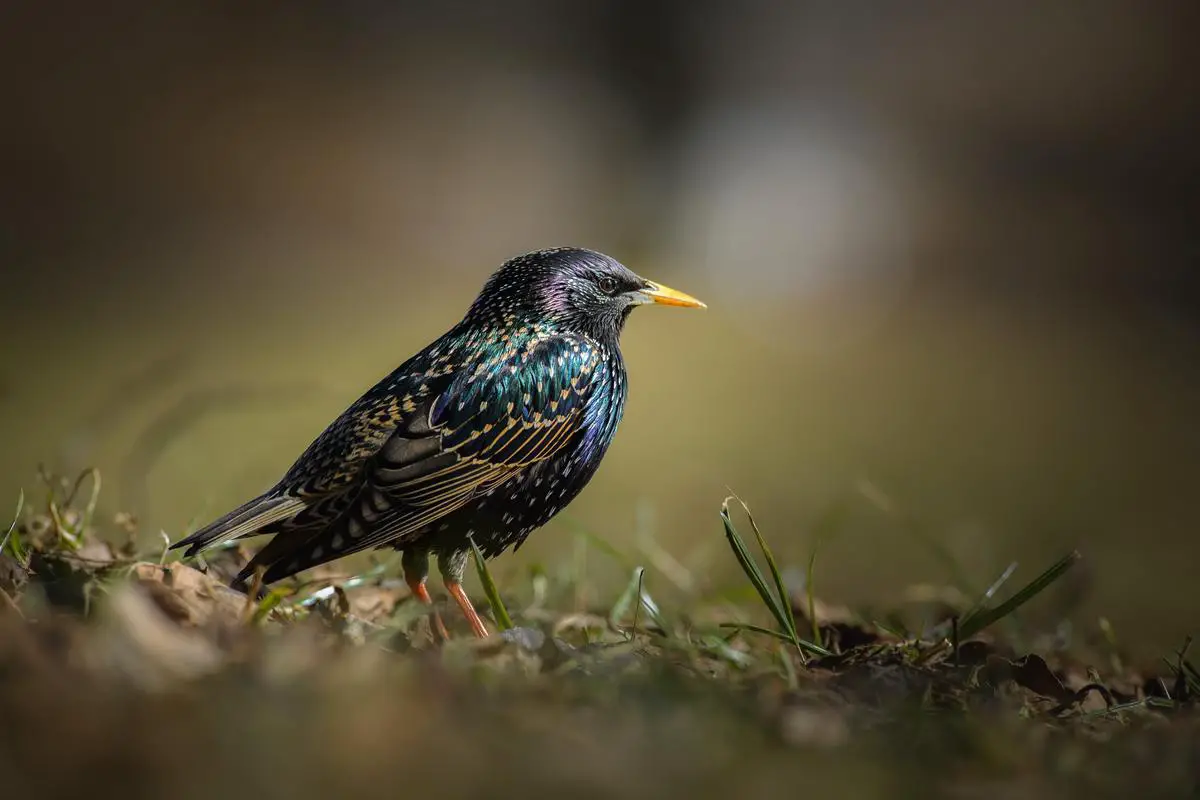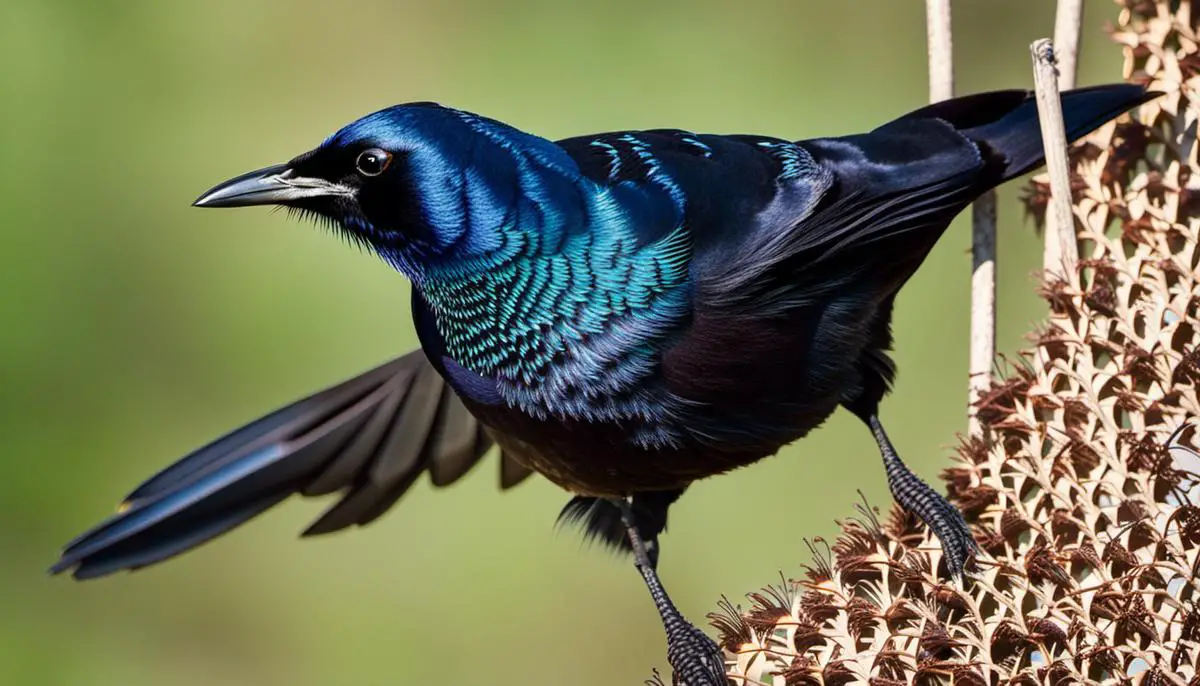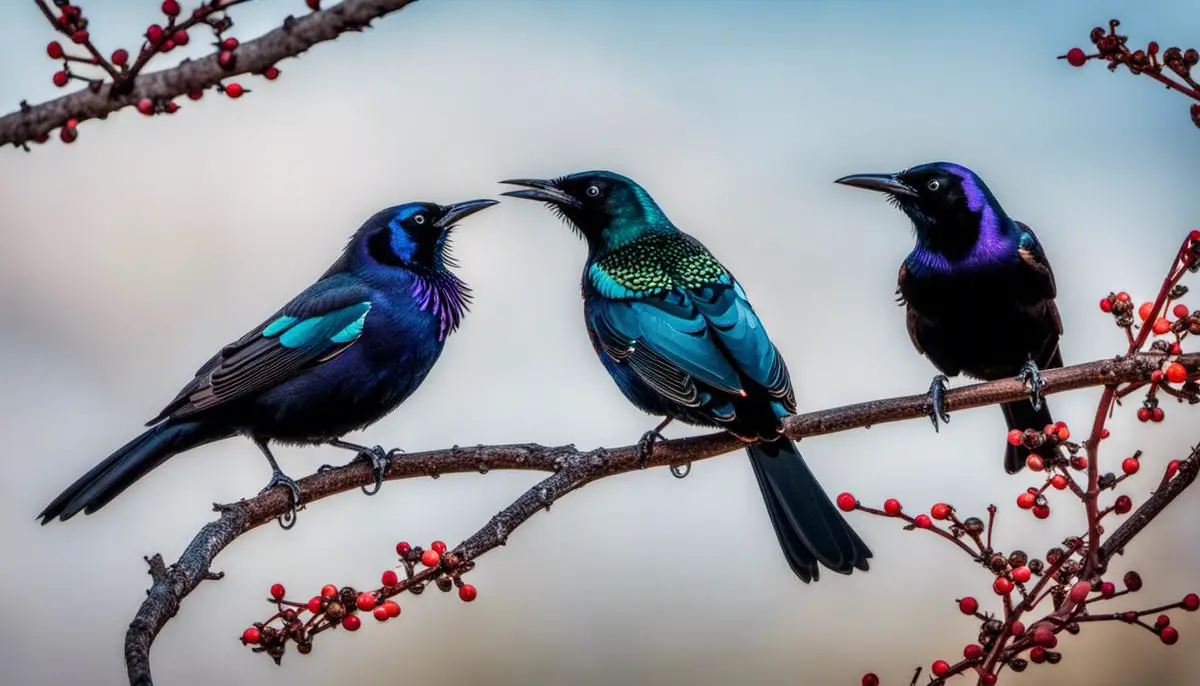In the diverse and fascinating world of ornithology, two avian species often pique the interest of birdwatchers and enthusiasts alike – the Grackle and the Starling. Both of these birds offer distinct experiences with their unique biological components, striking appearances, and adaptive behaviors. In an endeavor to educate the curious onlooker about these feathered beings, this article delves deep into the physical attributes, habitats, life patterns, and the conservation status of the Grackle and Starling. By exploring their size, plumage, and lifespan, to their distribution, nesting habits, dietary preferences and interaction with the environment, readers can gain a holistic understanding of these avian species and their place in the wider ecological matrix.
Biology and Physical Features of the Grackle and Starling
Physical Features: Grackle vs Starling
Grackles and starlings are two distinct bird species that bear some similarity but also have distinctive attributes.
On average, grackles are larger in size compared to starlings. Grackles can grow up to 12 to 17 inches long, with a wingspan ranging from 14 to 18 inches. Starlings, on the other hand, are approximately 7 to 9 inches long, and they leverage a wingspan of around 12 to 17 inches.
When it comes to plumage, differences are not only evident but also spectacular. Grackles have a dark plumage, typically black, but they also demonstrate a metallic sheen, especially in sunlight, which makes their feathers appear glossy and exhibit hues of purple, green, and blue. The starling also boasts an impressive plumage, which is mainly black but incredibly highlighted with specks of white, purple, and green. A starling’s plumage appears more speckled and iridescent.
Lifespan and Reproduction: Grackles vs Starlings
The typical lifespan for grackles can extend to 23 years for those in captivity, while in the wild, their longevity is usually around 11 years. On the flip side, starlings can live up to 20 years in captivity and about 2-5 years in the wild.
The reproduction of grackles and starlings also presents intriguing biological attributes. Grackles are polygynous, which means a single male mates with several females during the breeding season. On the contrary, starlings are monogamous, maintaining one partner during the breeding season.
Diet and Behavior: Grackles vs Starlings
From a dietary perspective, grackles and starlings are famous for their omnivorous tendencies. Grackles enjoy a varied diet that includes insects, berries, seeds, small fish, and even smaller birds or mice. Starlings, too, are omnivores, consuming an array of insects, fruits, seeds, and scraps of human food when available.
In terms of behavior, grackles are known for their aggression, especially when it comes to defending their territory or seeking food. Starlings also carry a reputation for being assertive and even invasive in certain areas.
Habitat and Range: Grackles vs Starlings
Grackles are native to North America, extending from Canada down to the Caribbean while demonstrating a preference for open areas such as fields, parks, and marshes. Converseley, starlings are originally native to Eurasia but have become widespread in North America since their introduction there in the 19th century. Starlings have thrived in various habitats, including open woods, gardens, and human-populated areas.
Grackles and starlings are two distinct bird species that can be differentiated easily by their unique physical characteristics, lifespan, reproductive behaviors, diet, and overall behavior. Accurate identification is enriched by a thorough appreciation and understanding of these individualistic features unique to each species.

Habitats and Geographic Distribution
Exploring the Habitats and Geographic Range of Grackles
The grackle species calls the Americas its home. Their presence spans across North, Central, and South America, moreover, they are prominently found in urban environments throughout the United States and their distribution also extends north to Canada and south into Central America.
Fascinatingly, grackles adapt exceedingly well in diverse habitats – open fields, wetlands, savannas, pastures, city parks, and even shopping centers. Their adaptability to human-dominated environments empowers them to exploit food resources and nesting sites that most other bird species would typically overlook.
Grackles enjoy a varied diet, consuming both plant and animal matter. This diet ebbs and flows depending on the habitat they’re in and the season they’re going through. Known as generalist foragers, their menu ranges from grains, fruits, insects, to small birds, mice, and they are not beyond scouring for human food scraps.
Habitats and Geographic Distribution of Starlings
Introduced to North America in the late 19th century, starlings are now widespread throughout the continent, covering a range that extends from parts of Alaska and Canada, down through the United States to northern Mexico. Originally, these birds are native to most of Europe and western Asia, and they have, over time, expanded their distribution to include South Africa, Australia, and New Zealand.
Starlings are known for their extraordinary adaptability, managing to thrive in various habitats. They can be found in both rural and urban areas, including city parks, farmlands, gardens, and forested regions. They are also found near human settlements, comfortably nesting in buildings, street lamps, and other man-made structures.
The diet of starlings is also notably varied, with food resources depending on the habitat and the season. Like grackles, they are generalist feeders, consuming a wide array of items from insects, berries, and small fruits, to grains and human food scraps.
The survival, behavior, diet, and breeding patterns of both grackles and starlings are significantly influenced by their habitats and geographic distribution. They have a broad global footprint, finding success in a diverse landscape of environments due to their notable adaptability. Despite these admirable attributes, their tendency to inhabit human settlements can often mark them as pests or disturb the peace. Regardless, these bird species exhibit remarkable resilience, thriving across wide geographic expanses.

Behaviors and Lifespan
Notable Features of Grackles
Grackles, medium-sized blackbirds recognized for their glossy appeal and characteristic loud calls, typically range between 4 and 8 years in their natural habitat. However, in controlled environments, they can survive up to an impressive 20 years. A true testament to their adaptability, their varied diet includes insects, minnows, frogs, eggs, berries, seeds, grain, and even small birds and mice. Notably, they don’t shy away from scavenging in human waste when nesting in urban locales.
Renowned for their intelligence, grackles exhibit exceptional problem-solving skills and adapt easily to new surroundings. They prefer moving in large flocks, and during the breeding season, their nesting grounds transform into exhibition spaces where males court females by fluffing up feathers, displaying expansive tails, and making unique call sounds. While grackles are typically non-aggressive towards humans, they are fiercely protective when defending their nests.
Starling Behavior and Lifespan
European Starlings, the species most common in North America, are known for their vibrant, iridescent feathers and short tails. In the wild, starlings tend to have a shorter life expectancy than grackles, with an average lifespan of 2–3 years. However, some specimens have been known to live up to 15 years.
Starlings are known to be highly adaptable and can thrive in a variety of environments, from urban areas to farmlands and forests. Much like grackles, starlings are omnivorous, although their diet leans towards insects and fruit. They will also eat seeds, berries, and occasional small vertebrates.
Starlings are extremely social birds, often seen in large flocks, especially during the winter months. These flocks can number into the tens of thousands. When it comes to breeding, starlings are cavity nesters, often taking over the abandoned nests of other birds. They are known to be aggressive when securing a nesting site, sometimes even ejecting the current occupants of a nest.
Grackle vs Starling Interaction
Grackles and starlings often occupy the same environments and have similar diets, so interaction between the two species is common. Both species will congregate around abundant food sources, much like bird feeders, resulting in competition for resources.
Additionally, the aggressive nesting behavior of starlings can lead to conflict with grackles during breeding seasons. Starlings can and do displace grackles from their nests, though the latter are known to put up a fight.
When it comes to interaction with humans, both starlings and grackles are often considered pests due to their noise, droppings, and habit of swarming bird feeders. On the other hand, both species are often praised for their intelligent behaviors and their role in controlling pest populations, such as insects and rodents.
Interaction with Other Bird Species
Between starlings and grackles, starlings are noted for their more aggressive interactions with other bird species, particularly during nesting season. They’re known to aggressively take over cavities and nests from smaller birds.
Grackles, while more peaceful than starlings, are not without their aggressive tendencies too. Their diet, which includes eggs and hatchlings, can make them a threat to smaller bird species during the breeding season. However, they generally coexist peacefully with other bird species when not breeding.
In Summary
Grackles and Starlings are remarkable creatures known for their interesting behaviors and unique survival tactics. With their ability to adapt to various environments, they flourish across numerous habitats. They play a crucial role within the ecosystem, including the control of certain pest populations, despite having occasional conflicting interactions with other bird species.

Conservation Status and Human Impact
Conservation Outlook: Comparing Grackles and Starlings
According to the International Union for Conservation of Nature (IUCN), both grackles and starlings enjoy a widespread presence throughout North America and are not at present posing any significant threat to their existence. The IUCN exclusively classifies both species under ‘Least Concern’. This classification signifies the stability and size of their populations and importantly points to there being no immediate danger of them becoming extinct.
Populational Trends and Human Impact
Despite their current stable status, grackles and starlings have exhibited fluctuating population trends in recent years, largely due to human activities. Starlings, which were introduced in North America from Europe in the late 19th century, have had a significant impact on native bird species, as they compete for the same nesting sites and food resources. Measures to control starlings have resulted in their decline in some areas. Grackles, on the other hand, have shown a general increasing trend in population. However, in regions exposed to intensive agricultural activities, both starlings and grackles face threats due to the use of pesticides and loss of habitat.
Protection Measures and Importance in Ecosystem
Protection measures for starlings and grackles are ongoing. Many bird conservation organizations are advocating for responsible pest management practices to mitigate the impact of pesticides on these birds. Moreover, laws like the Migratory Bird Treaty Act ensure that it’s illegal to harm, possess, or kill these birds without a permit.
Both species play a crucial role in our ecosystem. Starlings help control pests like ticks, slugs, and insects. While feeding in grasslands, starlings’ probing behavior helps aerate soil, encouraging nutrient cycling. Similarly, grackles feed on a variety of agricultural pests, providing an ecological service that benefits farmers.
Challenges in Conservation
Despite their ecological importance, starlings and grackles often face negative perceptions. Starlings are considered invasive and are often blamed for declines in native bird species due to their competitive nature. Grackles, due to their large size and boisterous behavior, can sometimes be seen as a nuisance. This can overshadow their role in the ecosystem and pose a challenge to their conservation. Public education plays a vital role in this regard, with initiatives aimed at spreading awareness about the ecological importance of these birds, and advocating for their protection.

The relationship between humans and bird species like the Grackle and Starling is a delicate one, affected by our activities, conservation efforts and imposed threats on their survival. As dwellers of our shared planet, it is imperative to understand and respect these winged creatures’ roles within our ecosystems. Their survival, distribution, and behaviors are not just fascinating facts to note but signify larger environmental narratives that we are a part of. By developing a deeper awareness and appreciation for the Grackle and Starling, not only do we become more informed observers, but we also potentially become more conscious, responsible inhabitants of this Earth, committed to the protection and preservation of our avian cohabitants.













